List of urban areas in the Nordic countries
This is a list of urban areas in the Nordic countries by population. The population is measured on a national level, independently by each statistical bureau. Statistics Sweden uses the term tätort (urban settlement), Statistics Finland uses also tätort in Swedish and taajama in Finnish, Statistics Denmark uses byområde (city), while Statistics Norway uses tettsted (urban settlement). The statistical definition is agreed upon in the Nordic countries:[1] a continuous built-up area whose population is at least 200 inhabitants and where the maximum distance between residences is 200 metres; discounting roads, parking spaces, parks, sports grounds and cemeteries – without regard to the ward, municipal or county boundaries.[1][2] This could be compared with census-designated places in the United States.
List
| Rank | City / urban settlement | Population | Notes | Image | |
|---|---|---|---|---|---|
| 1 | | 1,515,017 | Capital of Sweden. Municipality: 932,917. The Stockholm urban area, Urban Stockholm, or Tätorten Stockholm as it is called in Swedish, consists of the municipalities of Stockholm, Solna and Sundbyberg, as well as parts of Botkyrka, Danderyd, Haninge, Huddinge, Järfälla, Nacka, Sollentuna, Tyresö municipalities. Metropolitan area, Metropolitan Stockholm or Stor-Stockholm, 2,260,795 (2015). | 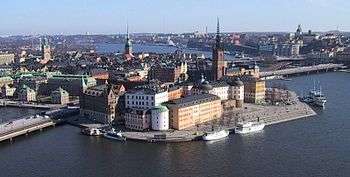 | |
| 2 | | 1,246,611[3] | Capital of Denmark. Municipality: 569,557. Urban Copenhagen, or Hovedstadsområdet (capital area) as it is also called in Danish, consists of the municipalities of Copenhagen, Frederiksberg, Albertslund, Brøndby, Gentofte, Gladsaxe, Glostrup, Herlev, Hvidovre, Lyngby-Taarbæk, Rødovre, Tårnby and Vallensbæk, as well as parts of the Ballerup, Rudersdal, Furesø, Ishøj and Greve municipalities. For the metropolitan area, Copenhagen metropolitan area or Hovedstadsregionen, 1,969,941 (2014) and for the Oresund Region circa 3,500,000. | ||
| 3 | | 1,231,595[4] | Capital of Finland. Municipality: 632,577. Urban Helsinki, or Helsingin kaupunkialue as it is called in Finnish, is defined by Statistics Finland. At minimum it includes most of the neighbouring municipalities Espoo, Vantaa and Kauniainen. For the Greater Helsinki area: 1,360,232. | ||
| 4 | | 942,084[5] | Capital of Norway. Municipality: 647,676. The Greater Oslo Region metropolitan area has a population of 1,546,706. Conurbation includes the neighbouring municipalities Bærum, Asker, Skedsmo, Lørenskog and Oppegård in their entirety, as well as parts of Røyken, Sørum, Nittedal, Rælingen and Ski. It is the fastest growing capital city in Europe.[6] | ||
| 5 | | 549,839 | Municipality: 536,790. For the official statistical entity Storgöteborg (Gothenburg Metropolitan Area): 964,323 |  | |
| 6 | | 317,316[7] | Municipality: 217,767. Eurostats population size for Tampere is 369,525.[8] |  | |
| 7 | | 280,415 | Municipality: 307,600. For the official statistical entity Stormalmö (Malmö Metropolitan Area): 658,704 and for the Oresund Region circa 3,500,000 |  | |
| 8 | | 264,716[9] | Municipality: 330,639.[10] Which is a part of the East Jylland region with a population of 1,279,492. Eurostats population size for Aarhus is 845,971.[8] |  | |
| 9 | | 254,671[7] | Municipality: 180,546. |  | |
| 10 | | 247,731[5] | Municipality: 267,150. Metropolitan area: 377,116. | 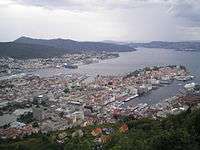 | |
| 11 | | 203,771[5] | Municipality: 128,830. Metropolitan area: 297,569.
Conurbation includes the neighbouring municipalities Sandnes, Randaberg and Sola. |
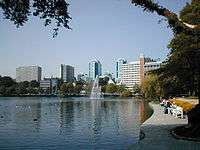 | |
| 12 | | 201,049 | Capital of Iceland. Municipality: 118,898. Includes the neighbouring municipalities Kópavogur, Hafnarfjörður, Garðabær, Mosfellsbær, Seltjarnarnes and Álftanes. Metropolitan area: 220,000 – 240,000 (30 minute / 1 hour commute)[11] (2011). | ||
| 13 | | 188,279[7] | Municipality: 191,237 | 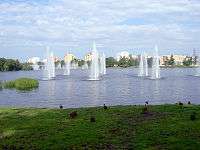 | |
| 14 | | 172,512[12] | Municipality: 195,797 | ||
| 15 | | 169,972[5] | Municipality: 180,280. Metropolitan area: 274,958. | 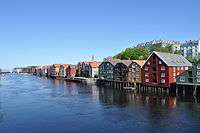 | |
| 16 | | 140,454 | Municipality: 197,787 |  | |
| 17 | | 130,853[12] | Includes Nørresundby; Municipality: 205,809 | ||
| 18 | | 117,974[7] | Municipality: 134,756 |  | |
| 19 | | 116,549[7] | Municipality: 103,187 | ||
| 20 | | 110,877 | Municipality: 137,207 | 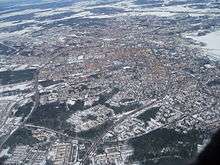 | |
| 21 | | 110,503[5] | Includes the neighbouring municipality Nedre Eiker in its entirety, as well as parts of Øvre Eiker, Lier and Røyken. |  | |
| 22 | | 107,038 | Municipality: 135,460 | 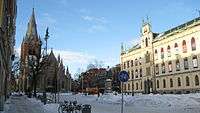 | |
| 23 | | 106,758[5] | Fredrikstad with 61,264 inhabitants and Sarpsborg with 44,281 have grown together, to form an urban area known as "Nedre Glommaregionen" (the Lower Glomma Region – The cities are placed along the outlet of the river Glomma, hence the name). | ||
| 24 | | 104,232 | Municipality: 146,416 | 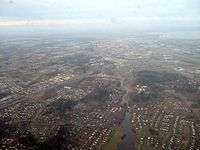 | |
| 25 | | 97,122 | Municipality: 129,177 |  | |
| 26 | | 90,621[5] | Includes the neighbouring municipalities of Porsgrunn and Skien in its entirety, as well as a part of Bamble. | 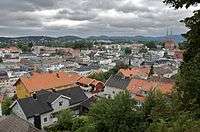 | |
| 27 | | 89,396 | Municipality: 127,382 | ||
| 28 | | 87,247 | Municipality: 130,050 | 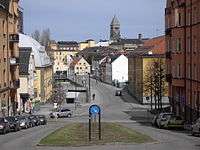 | |
| 29 | | 84,442[7] | Municipality: 83,473 | 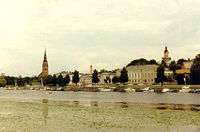 | |
| 30 | | 83,454[7] | Municipality: 105,229 |  | |
| 31 | | 82,800 | Municipality: 110,488 |  | |
| 32 | | 79,594 | Municipality: 115,473 | ||
| 33 | | 71,618 | Municipality: 115,095 | 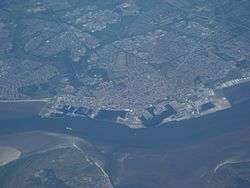 | |
| 34 | | 71,033 | Municipality: 95,055 | ||
| 35 | | 66,273 | Municipality: 103,294 | 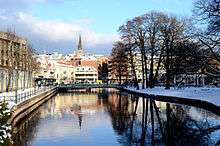 | |
| 36 | | 65,414[7] | Municipality: 66,401 |  | |
| 37 | | 64,679 | Municipality: 96,311 | 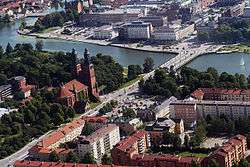 | |
| 38 | | 64,619 | Municipality: 86,246 |  | |
| 39 | | 64,108[7] | Municipality: 74,457 | 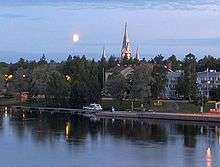 | |
| 40 | | 61,685 | Municipality: 85,753 |  | |
| 41 | | 61,272 | Municipality: 63,789 | _2009.jpg) | |
| 42 | | 61,163 | Municipality: 96,343 |  | |
| 43 | | 60,887 | Municipality: 83,005 | 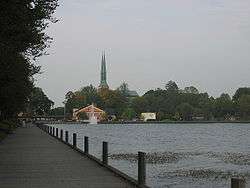 | |
| 44 | | 58,662[5] | Municipality: 78,320 |  |
|
| 45 | | 58,577 | Municipality: 91,800 | ||
| 46 | | 58,021 | Municipality: 90,066 | 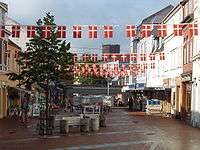 | |
| 47 | | 55,884 | Municipality: 85,662 |  | |
| 48 | | 54,567[7] | Municipality: 72,748 | 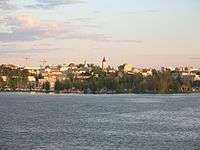 | |
| 49 | | 53,230 | Municipality: 109,652 |  | |
| 50 | | 52,922[7] | Municipality: 54,845 |  | |
| 51 | | 50,842[7] | Municipality: 61,166 |  | |
| 52 | | 50,712 | Municipality: 96,977 | 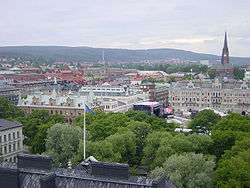 |
Note that the population numbers from the different countries are from different years, as Statistics Norway and Statistics Denmark release the statistic yearly (albeit at different times of the year), Statistics Sweden only release the figures every five years. The Norwegian data is from 2013,[5] the Danish data is from 2014,[13] the Swedish is from 2010[14] and the Finnish is from 2012.[7]
See also
- Largest metropolitan areas in the Nordic countries
- List of the most populated municipalities in the Nordic countries
- List of metropolitan areas in Sweden
- List of urban areas in Sweden by population
- List of urban areas in Denmark by population
- List of urban areas in Norway by population
- List of urban areas in Finland by population
- List of cities in Iceland
- List of cities in the Baltic states
- List of metropolitan areas by population
References
- 1 2 "Nationalencyklopedin - Tätort". Nationalencyklopedin. Retrieved 21 July 2014.
Translation: 'a for the Nordic countries shared statistical definition of built-up area with at least 200 residents, not more than 200 m between each other (without regard to the ward, municipal or county boundaries)'
- ↑ "Localities 2010: Population, age and gender" (PDF) (in Swedish and English). Statistics Sweden. Retrieved 21 July 2014.
A densely built area includes any cluster of buildings with at least 200 inhabitants, unless the distance between the houses exceeds 200 metres. However, the distance may exceed 200 metres if the cluster of buildings is situated within the area of influence of a larger locality. [...] Even if the distance between buildings exceeds 200 metres, the locality should not be divided if the area between the buildings is used for public purposes such as roads, parking spaces, parks, sports grounds and cemeteries. The same applies to undeveloped areas such as storage sites, railways and docks.page=21
- ↑ http://www.statistikbanken.dk (BEF44)
- ↑ http://pxnet2.stat.fi/PXWeb/pxweb/en/StatFin/StatFin__vrm__vaerak/156_vaerak_tau_344_fi.px/table/tableViewLayout1/?rxid=cda0d721-f43c-44ff-88bd-8e2cce42d3ed Urban settlements by population and population density, 31 Dec 2015
- 1 2 3 4 5 6 7 8 9 Citypopulation Norway
- ↑ http://www.bbc.com/news/world-europe-25722053
- 1 2 3 4 5 6 7 8 9 10 11 12 13 Urban settlements by population and population density, 31 Dec 2012
- 1 2 http://appsso.eurostat.ec.europa.eu/nui/show.do?dataset=urb_lpop1&lang=en
- ↑ http://www.statbank.dk/BY1
- ↑ http://www.statistikbanken.dk/statbank5a/default.asp?w=1680
- ↑ http://www.statice.is/Statistics/Population/Urban-nuclei-and-zip-codes
- 1 2 http://www.statistikbanken.dk/statbank5a/SelectVarVal/Define.asp?Maintable=BEF44&PLanguage=1
- ↑ Citypopulation DENMARK: Major Cities
- ↑ Citypopulation SWEDEN